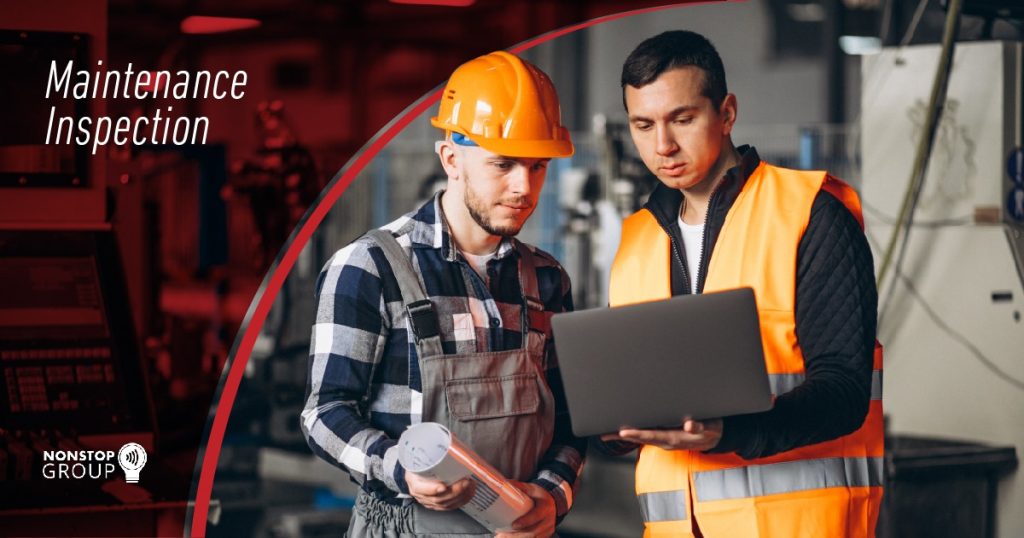6 Min Read

Companies in the manufacturing industry lose nearly 50 billion dollars every year due to unplanned downtime. Machine downtime is one of the most costly events for a company, especially manufacturing companies, as it can lead to increased labor costs, reduced production capacity, lost revenues, and tighter profit margins.
When investigated, researchers concluded that downtime is often the result of an inefficient maintenance plan. Failure to predict impending breakdowns on time is detrimental to an organization’s operational efficiency. Moreover, a lack of focus on operational excellence and bad maintenance practices can hold an organization back.
The maintenance inspection is a proactive endeavor that enables companies to remain informed and equipped ahead of time. Reduced downtime, extended equipment life, minimized repair time, and maintenance cost reduction are some benefits that a company can unlock, all thanks to timely inspection. Consequently, your asset-intensive organization can easily benchmark maintenance performance.
This guide covers all your organization needs to know about effective maintenance inspections so you can pinpoint maintenance requirements in time, improve uptime and avoid disruption to operations. Let’s get started!
What Is A Maintenance Inspection?
The purpose of an ‘Inspection’ is to review and take note of the current condition of an asset that is used in operations. Inspections can occur after an asset has failed or prior to it as a preventive measure. This preventive approach includes visual examinations, system cleanings, replacements, and fixtures.
Maintenance workers inspect the equipment and machinery to ensure they continue to operate without failure. In case of a potential defect, the maintenance inspector’s job is to determine the tools, labor, and material required for servicing. By doing this, the assets always remain in good working condition, operating safely and meeting quality standards.
Why Are Maintenance Inspections Important?
A maintenance inspection is a process of assessing the condition of organizational assets in order to ensure there is no unexpected system failure or compromise. Every asset that’s critical to operations should be inspected however times needed, dependent on the asset, to ensure its operational continuity.
There are many reasons why a well-executed inspection is pivotal for a company, but five of the most important are listed below:
- Maintenance inspections identify equipment issues and their performance gaps, allowing for timely maintenance attention and avoidable costly repairs.
- Maintenance inspections pinpoint recurring problems and save the business from recurring sky-high repair costs.
- Performing pre-use equipment inspections can reduce maintenance costs and increase the lifecycle and durability of the equipment.
- Critical inspection data is gathered on the existing equipment performance that later assists in obtaining the right equipment, material, and tools.
- Regular inspections ensure the maintenance crew is doing their best to take care of the organization’s valuable assets.
Smarter Asset Tracking With NFC Tags
Learn more about how NonStop Suite's NFC Asset Tracking Solution can help your Enterprise streamline operations to new heights.
Get A Free Product Tour
Types of Maintenance Inspection
Different industries require different inspection checklists. However, there are 9 types of inspections that are common to almost every industry. These are:
Safety Inspections
Safety inspections are explained as an on-site examination of potential hazards to the occupants and personnel of a company. It includes reviewing and restocking the safety equipment for remedial action. Fire extinguishers, emergency eyewash, showers, and medical essentials like first-aid kits are checked to ensure appropriate working order.
Failure Finding Inspections (FFI)
FFIs are a core part of a routine maintenance program. These inspections are performed on specific equipment to uncover hidden or potential failures. Any equipment required to function in an emergency or as a backup is carefully checked during a failure finding inspection. For example, checking a backup generator’s operational power comes under the testing of failure.
Lighting Inspections
Lighting inspections are a critical part of maintenance planning. During a lighting inspection procedure, facility managers evaluate, replace and fix the lighting appliances and facilities as needed. All the lighting controls, filters, cables, hardware, and baffles on transformer systems are carefully inspected to get any major problems and potential obstructions out of the way.
Electrical Inspections
The purpose of an electrical inspection is to identify potential fire hazards or risks of electrocution. The facility manager checks all electrical appliances, connections, and wiring. This includes timers, photocells, exhaust fans, and batteries in smoke and monoxide detectors. By identifying potential hazards, electrical inspections help to prevent accidents and ensure compliance with safety regulations.
HVAC Inspections
HVAC (Heating, Ventilation, and Air Conditioning) inspection thoroughly examines the heating and cooling equipment. This inspection includes all the components responsible for controlling the temperature in an expanse, including the air intake, motors, filters, and ductwork. Quality checkups and maintenance should be performed at regular intervals to ensure the proper functioning of the HVAC system.
Pro Tip: The NonStop Group’s electronic forms can help automate your maintenance checklists and improve oversight of the maintenance process.
Building Interior Inspections
The building interior inspection diagnoses the problems present inside a factory building. The maintenance inspectors check the walls, interior ceilings, floors, roof, leakages, and other deterioration to look for visual clues found indoors. Depending on this assessment, the inspector notifies the maintenance crew about the building’s condition and the probable hazards.
Building Exterior Inspections
In this inspection, the architectural details lying outside the factory building, such as paint, walls, windows, and doors, are closely examined for their durability. The maintenance inspector is also responsible for checking any foliage from the drains and gutters that may weaken the building’s foundation.
Fire Protection Maintenance Inspection
As the name suggests, fire protection maintenance inspection deals with assessing the assets carrying a great deal of risk of fire breakouts. This inspection guarantees that the potential fire hazards are subsided with due diligence and that the company complies with local fire standards. Additionally, all the fire emergency and safety equipment are tested to ensure they are functional in the time of need.
Plumbing Inspection
The plumbing systems in a company require a comprehensive inspection at least once a year. All the water supply systems, including water chillers, circulation pumps, and condenser fans, require inspection and lubrication regularly. Water boilers and heaters must be tested against fire risks. Any water leakages, unusual noises, and damages might be signs for maintenance.
Tips For A Successful Maintenance Inspection Process
A maintenance inspection is an ongoing endeavor. Every maintenance inspector has to schedule an inspection at decent intervals to confirm that the asset performance is enhanced with minimum downtime. Experts recommend the following three tips to help ensure optimal performance during inspections:
Schedule Maintenance Inspections Frequently
Every company wanting to comply with safety regulations should schedule maintenance inspections routinely to prevent minor issues from turning into major breakdowns. Otherwise, it could result in decreased wrench time and equipment lifespan. An inspection should be performed annually, on average. To simplify this frequency count, take the average failure development period and divide it by two. The result is how often your company needs to schedule an inspection in order to identify issues ahead of time.
Use Checklists
A maintenance inspection checklist comes in handy when conducting a health checkup on your assets. It is the documentation of what equipment, assets, or services need to be examined during the time schedule. This simple efficiency assures that the inspection procedure goes smoothly and that no critical aspect of the inspection plan goes unattended. Additionally, creating inspection checklists helps determine the modifications, as well as indicate the date and type of check performed on these modifications.
Pro Tip: Employ smart solutions like the NonStop Suit’s dynamic e-forms to simplify the process. Create, share, access, and collaborate on a digital inspection checklist that is easier to record, maintain and update.
Create Efficient Inspection Routes
Did you know that nearly 20.9% of work hours are wasted on unnecessary traveling about the facility? Creating efficient inspection routes can save most of these hours, if not all, and turn them to use for augmented organizational productivity.
The inspection routes in your company should be simplified and distributed into multiple smaller routes. An excessively long inspection route may keep the technicians from performing an optimal job at the site, leaving potential errors and loopholes unattended and unresolved.
Additionally, pre-planned routes prove to be advantageous for maintenance schedules. By implementing this small yet effective strategy, the inspection crew can easily save those lost hours and enhance schedule compliance.
Conclusion: Inspections Made Easy With The NonStop Suite!
The importance of inspections in the field service industry cannot be overstated. Routine inspections of equipment, machinery, and other assets can save a company from hours of legwork, hefty repair costs, and lost working hours.
However, managing the inspection process can be a challenge for most businesses. NonStop Suite provides smart solutions to help streamline your workflow.
The NonStop Suite’s dynamic e-forms enable you to easily create, share, access, and track inspection documents and checklists. While your data is end-to-end protected in a cloud-based EAM, the inspection data is readily available at your fingertips. To top it all, NonStop Suite also offers an NFC asset tagging feature. You can scan your equipment, and the history of all the maintenance and inspection done on the unit is accessible to you in real-time. Simply put, with NonStop Suite e by your side, you can enhance the longevity of your critical assets, balance your inspection schedule and elevate your customer relationships! Shall you want to simplify the maintenance inspection program, consult with the NonStop Group today or book a free product tour.


